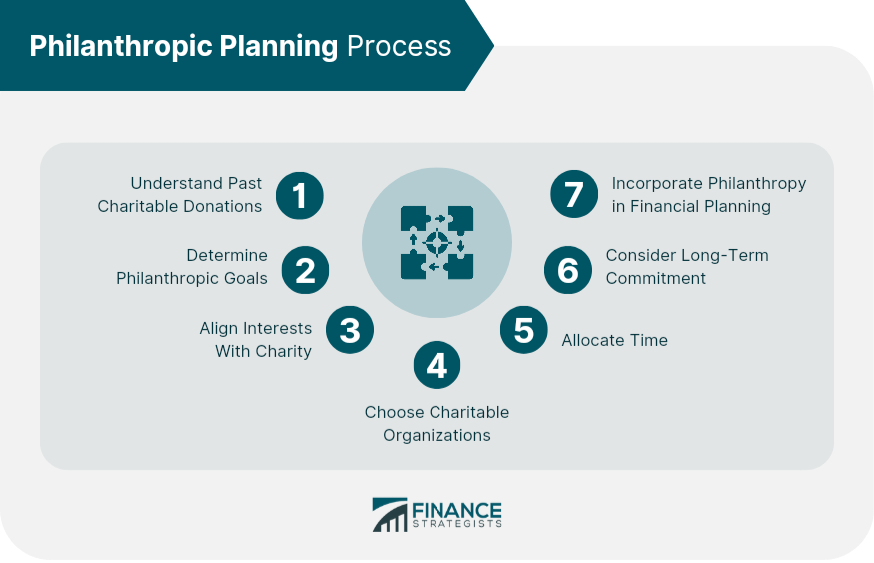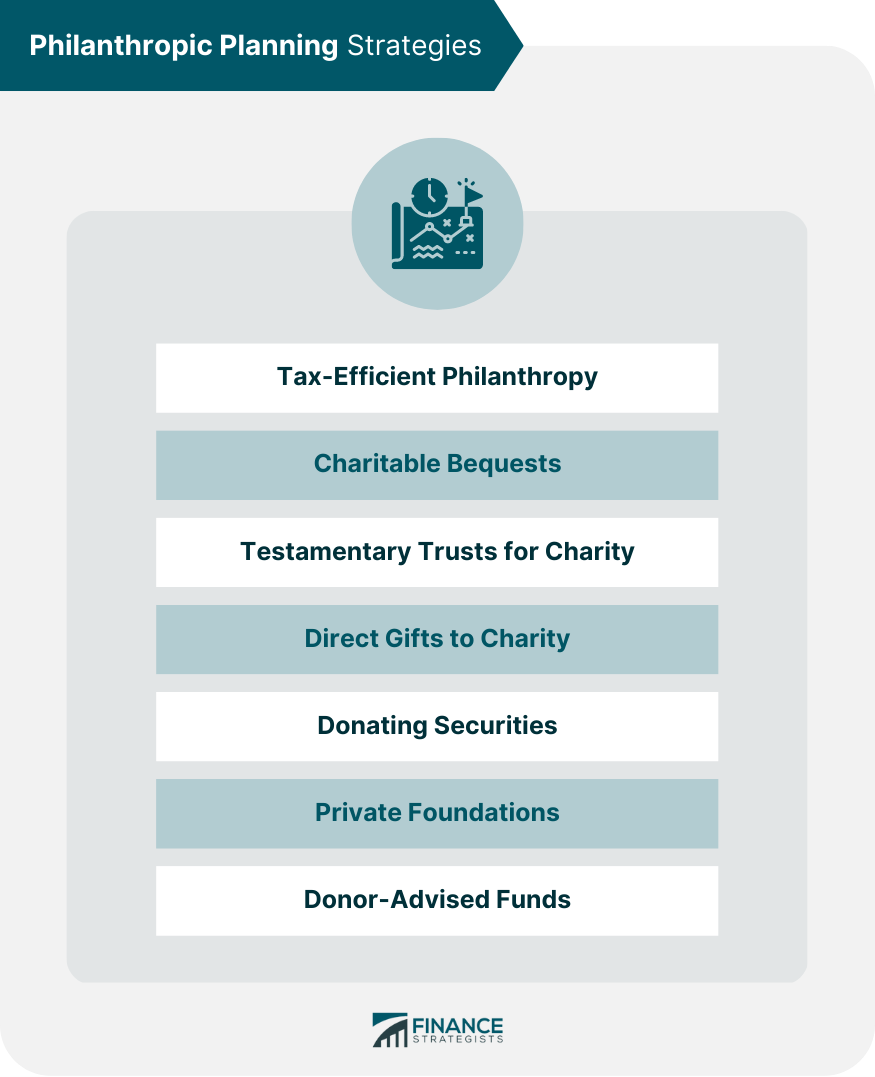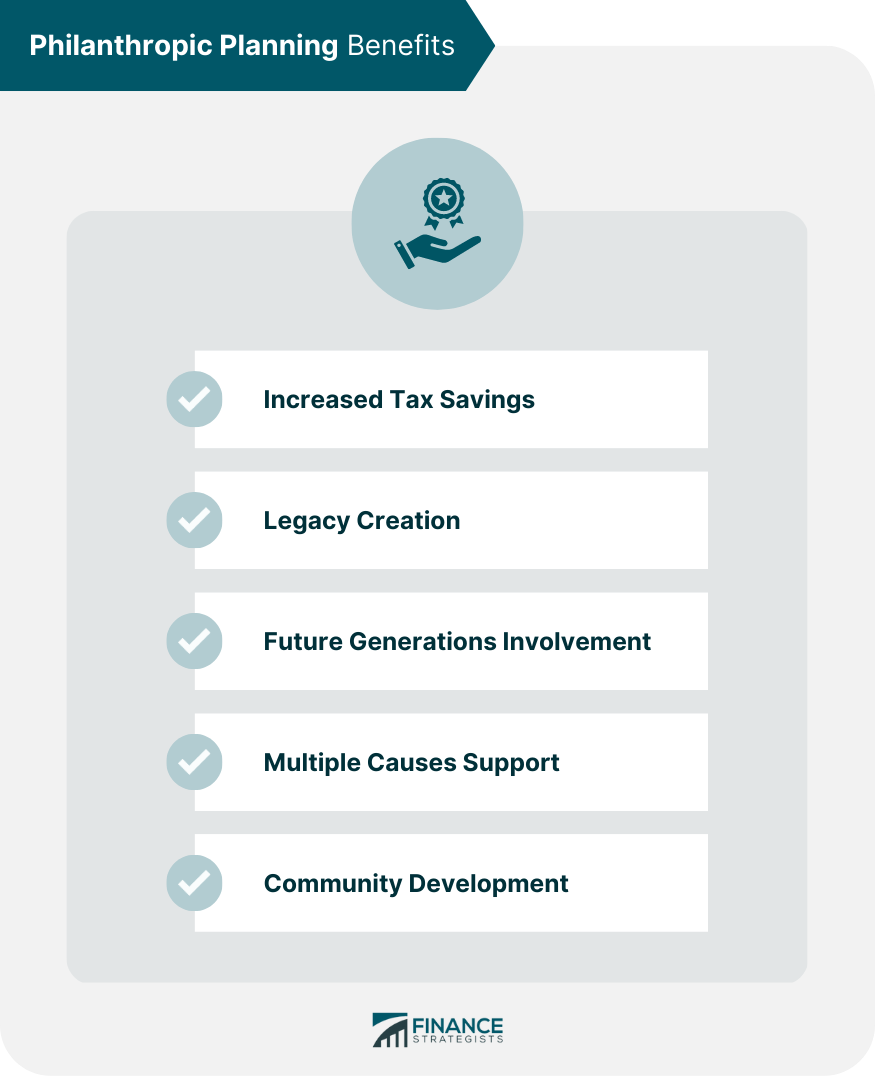Philanthropic planning refers to creating a comprehensive strategy for charitable giving that aligns with an individual's or organization's values, goals, and financial resources. This approach involves developing a plan identifying the most effective and efficient ways to make charitable contributions, considering tax implications and the potential impact on the philanthropic causes being supported. Whether through an endowment, private charity, public or private foundation, or donor-advised fund, philanthropic planning is often part of a comprehensive wealth management strategy. Collaborating with financial advisors, lawyers, and other experts is frequently a part of philanthropic planning and typically encompasses crafting a statement of purpose that details the objectives and principles of the charitable donations. Giving to charitable causes is about more than just maximizing income tax benefits. It is about using wealth to have a beneficial and long-term impact on the community and the larger world.
Philanthropic planning involves developing a thoughtful and strategic approach to making donations. The following steps can guide individuals and organizations through the philanthropic planning process: Review donations you have made as an individual or company. Consider any areas that may have been neglected in the past. Aside from reviewing past donations, identify the causes you have supported and evaluate the impact of your contributions. The next step involves identifying the causes that you are most passionate about. Define the impact you want to make, and establish a clear set of objectives for your charitable giving. These could be focused on a particular cause, such as healthcare or education, and support for local communities through organizations. Clear philanthropic goals will guide decisions about who and what to donate. Make sure that the goals align with your interests and values. This will ensure that any donations are meaningful and represent who you are as a person or company. Online databases provide information about nonprofits, including their financials, mission, and impact. These databases can help you identify organizations making a meaningful impact on the causes you care about. After identifying the organizations that align with your interests, the next step is choosing the charitable organizations you will support. This process involves donating to multiple organizations or selecting a single organization. When choosing charities, consider factors such as how effective their operations are. Assess how transparent they are about their finances and how much money donated goes directly towards their cause compared to overhead costs. In addition to financial contributions, philanthropic planning also involves allocating time to charitable causes. This can include volunteering your time or expertise to organizations you support and serving on nonprofit boards or committees. Volunteering at local events organized by nonprofits is an excellent way to build relationships with those involved. At the same time, it gives direct access to people directly impacted by the supported cause, which can provide unique insight into its efficacy. Philanthropic planning is a long-term commitment, and it is essential to consider the sustainability of your contributions over time. This may involve developing a multi-year giving plan or establishing a charitable foundation to ensure the longevity of your charitable impact. Incorporate some financial planning into the equation to allocate resources optimally towards projects without compromising personal finances too drastically, which usually involves establishing separate accounts. This may require working with a financial advisor or wealth management services to develop a budget for charitable giving. Similarly, such professionals can help evaluate your contributions' tax implications and identify the most effective ways to maximize the impact of your donations. There are various strategies that individuals and organizations can use to maximize the impact of their charitable donations. The following are some of the most common: Tax-efficient philanthropy involves structuring charitable donations to maximize tax benefits. Charitable donations can qualify for deductions in a given tax year or using tax-advantaged vehicles such as charitable remainder trusts or gift annuities. In this case, assets are passed down upon death or through a trust established before death. These assets can be given to charity without affecting the donor's estate taxes or other financial liabilities. A charitable bequest leaves a portion of an individual's estate to a charitable organization in a will. This is a simple way to make a charitable contribution and can effectively leave a lasting legacy. Testamentary trusts for charity are another option for those wishing their donor's funds to remain active after they pass away. It allows someone's funds to be distributed as outlined within a will or trust document allowing them to continue helping others even after death. This type of trust provides regular donations or a lump sum to the charity over a set period. It also allows the donor to specify terms and conditions on how the funds should be used. Direct gifts involve making a one-time or ongoing donation to a charitable organization. This is one of the simplest and most common ways to give to charity. It allows individuals to support causes they care about without creating complex legal arrangements. This method has limited paperwork requirements, making it easy and efficient for those wishing to donate directly from their pocketbooks or personal accounts. It does not involve outside intermediaries or additional entities such as foundations or trusts. Donating a publicly listed security that has increased in value can benefit from eliminating the capital gain tax and the donation tax credit. This presents an opportunity for tax savings compared to selling the security and making a cash donation. Donating securities involves giving stocks, bonds, or other securities to a charitable organization. A private foundation is a nonprofit organization created by an individual or family to support charitable causes. Donors can receive an immediate tax deduction for contributions made to the foundation. The foundation's assets can grow tax-free. In addition, private foundations are not subject to the same tax rules as public charities, which means they have more flexibility in distributing their assets. These funds are charitable giving accounts managed by a sponsoring organization. Individuals can make tax-deductible donations to the fund and then recommend grants to charitable organizations without the commitment necessary for a private foundation. Donor-advised funds provide the most significant potential benefits because they allow donors flexibility while maintaining control over grant distributions. Clients can direct funds toward a variety of different organizations. The following are some of the most significant benefits of philanthropic planning: By taking advantage of charitable giving options such as donating securities, creating philanthropic trusts, or establishing donor-advised funds, donors can maximize their tax benefits while supporting causes they care about. Another advantage of philanthropic planning is the ability of donors to create a lasting legacy in their name or that of their families. By selecting specific charities or causes to support over time, donors can ensure that their values and ideals live on well after they have passed away. Future generations have the potential to become involved through inheritance and education. Families can pass on the importance of giving back while encouraging children and other relatives to participate in charitable giving activities. Donors have the opportunity to make an impact across many levels at once. By donating to multiple charities or establishing a donor-advised fund, diversify their philanthropic portfolio and ensure more people receive help. Philanthropy can positively affect entire communities by providing resources for projects that governments or other entities may not otherwise fund or support. Supporting community development initiatives help build a more vital and vibrant community for everyone. Through philanthropic planning, individuals and organizations can maximize the impact of their charitable giving. At the same time, they can minimize taxes and ensure that their contributions align with their overall financial and philanthropic goals. This process can be precious for high-net-worth individuals and families who want a comprehensive method that involves developing a thoughtful and strategic approach to making donations. One should start by understanding their past charitable donations. Next, they should determine their philanthropic goals and choose the charitable organizations they want to commit to. Additionally, incorporating financial planning can help maximize the impact of donations. Strategies in philanthropic planning include tax-efficient philanthropy, charitable bequests, testamentary trusts for charity, direct gifts to charity, donating securities, private foundations, and donor-advised funds. Ultimately, philanthropic planning can create a lasting legacy, involve future generations, and support multiple causes. It also has the potential to impact entire communities through development initiatives positively. Consider speaking to an expert in wealth management for guidance in your philanthropic efforts.What Is Philanthropic Planning?
How Philanthropic Planning Works
Understand Past Charitable Donations
Determine Philanthropic Goals
Align Interests With Charity
Choose Charitable Organizations
Allocate Time
Consider Long-Term Commitment
Incorporate Philanthropy in Financial Planning

Philanthropic Planning Strategies
Tax-Efficient Philanthropy
Charitable Bequests
Testamentary Trusts for Charity
Direct Gifts to Charity
Donating Securities
Private Foundations
Donor-Advised Funds

Benefits of Philanthropic Planning
Increased Tax Savings
Legacy Creation
Future Generations Involvement
Multiple Causes Support
Community Development

Final Thoughts
Philanthropic Planning FAQs
Philanthropic planning allows individuals and organizations to make a thoughtful and strategic approach to charitable giving and maximize their donations' impact. With philanthropic planning, donors can set goals, choose organizations, and allocate time and resources to create a lasting legacy of charitable giving. It also provides significant tax benefits and can involve future generations in giving back to the community.
Developing a philanthropic planning strategy involves identifying one's values and passions, determining philanthropic goals, researching and selecting appropriate charities, deciding on the form and timing of donations, and seeking professional advice to maximize the impact of charitable giving.
Philanthropic planning is the process of strategically allocating funds toward charitable organizations. It results in maximizing the impact of donations. It involves taking advantage of various giving options, such as trusts and foundations, to reduce the amount of tax due on income and create a lasting legacy for donors and their families.
There are tax benefits associated with philanthropy. Individuals can receive tax deductions on their income tax returns by making charitable donations. Additionally, donations such as appreciated securities or property can provide even more significant tax benefits. Private foundations and donor-advised funds can also offer substantial tax advantages.
It can enhance the company's reputation by demonstrating a commitment to social responsibility and community involvement. This can increase customer loyalty, positive media coverage, and improved brand recognition. Additionally, philanthropy can help businesses attract and retain talented employees who value corporate social responsibility. Philanthropic activities provide networking opportunities and enhance relationships with other companies, government, and community leaders.
True Tamplin is a published author, public speaker, CEO of UpDigital, and founder of Finance Strategists.
True is a Certified Educator in Personal Finance (CEPF®), author of The Handy Financial Ratios Guide, a member of the Society for Advancing Business Editing and Writing, contributes to his financial education site, Finance Strategists, and has spoken to various financial communities such as the CFA Institute, as well as university students like his Alma mater, Biola University, where he received a bachelor of science in business and data analytics.
To learn more about True, visit his personal website or view his author profiles on Amazon, Nasdaq and Forbes.















